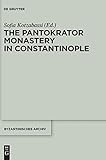The Pantokrator Monastery in Constantinople / Sofia Kotzabassi.
Material type: TextSeries: Byzantinisches Archiv : Als Ergänzung zur Byzantinischen Zeitschrift ; 27Publisher: Berlin ; Boston : De Gruyter, [2013]Copyright date: ©2013Description: 1 online resource (270 p.)Content type:
TextSeries: Byzantinisches Archiv : Als Ergänzung zur Byzantinischen Zeitschrift ; 27Publisher: Berlin ; Boston : De Gruyter, [2013]Copyright date: ©2013Description: 1 online resource (270 p.)Content type: - 9781614515999
- 9781614514602
- 200.9 22/ger
- BX385.I752 P366 2013
- BX385.P367
- online - DeGruyter
- Issued also in print.
| Item type | Current library | Call number | URL | Status | Notes | Barcode | |
|---|---|---|---|---|---|---|---|
 eBook
eBook
|
Biblioteca "Angelicum" Pont. Univ. S.Tommaso d'Aquino Nuvola online | online - DeGruyter (Browse shelf(Opens below)) | Online access | Not for loan (Accesso limitato) | Accesso per gli utenti autorizzati / Access for authorized users | (dgr)9781614514602 |
Frontmatter -- Preface -- Contents -- Abbreviations -- History -- The Komnenoi and Constantinople before the Building of the Pantokrator Complex -- The Foundation of the Pantokrator Monastery in Its Urban Setting -- The Monastery of Pantokrator between 1204 and 1453 -- Byzantine Officials in the Typikon of the Monastery of Christ Pantokrator in Constantinople -- References to the Monastery of Pantokrator in Old Slavic Literature (14th-15th c.) -- The Monastery of Pantokrator in the Narratives of Western Travellers -- Texts -- George Skylitzes’ Office on the Translation of the Holy Stone -- The Icon of the Three Holy Hierarchs at the Pantokrator Monastery and the Epigramms of Theodore Prodromos on Them -- Feasts at the Monastery of Pantokrator -- Empress Piroska-Eirene’s Collaborators in the Foundation of the Pantokrator Monastery: The Testimony of Nikolaos Kataphloron -- Das Pantokratorkloster von Konstantinopel in der byzantinischen Dichtung -- Selected bibliography on the monastery of Christ Pantokrator -- Index -- Plates
restricted access online access with authorization star
http://purl.org/coar/access_right/c_16ec
The Monastery of Pantokrator, founded by John II Komnenos and his wife Piroska-Irene, is not only one of the most important and most impressive monastic complexes of the Komnenian age, it is also one of the few to occupy a key position in the life of Constantinople in the Palaiologan age, given that its mortuary chapel (Heroon) was also the last resting place of many members of the latter dynasty. The first attempt to chronicle its history, based on the texts known at the time, was undertaken by G. Moravscik (1932). Interest was rekindled by P. Gautier’s critical edition of its Typikon (1971), and more recently by restoration work on its buildings. This volume brings together a comprehensive selection of all the texts concerning or connected with the Monastery of Pantokrator, and through them it demonstrates the Monastery’s importance and its role throughout the history of the Byzantine Empire-a role that has received insufficient attention, given that older studies have tended to focus on the 12th century. The texts cover the situation in Constantinople before the Monastery was founded, the historical and cultural context within which it was established, its Typikon (monastic formulary), the descriptions of Slav and Western travellers, the Byzantine texts (homiletic, historical, hagiographic, and poetic) relating to the Monastery and its history from the 12th to the 15th century, the Byzantine officials associated with it, and the celebration of the principal festivals in its churches. It also contains critical editions of and commentaries on the two versions of the Synaxarion of Irene Komnene, a speech referring to the Empress’s associate in the construction of the Monastery, another on the translation of the icon of St. Demetrios from the Church of St. Demetrios in Thessalonica to the Monastery of Pantokrator, an Office of the Translation of the Holy Stone, the verse Synaxarion composed for the consecration of the Monastery, and the known and unpublished poems by Byzantine poets (12th-15th c.) relating to it, as well as an extensive bibliography.
Issued also in print.
Mode of access: Internet via World Wide Web.
In Greek, Modern (1453-).
Description based on online resource; title from PDF title page (publisher's Web site, viewed 28. Feb 2023)


